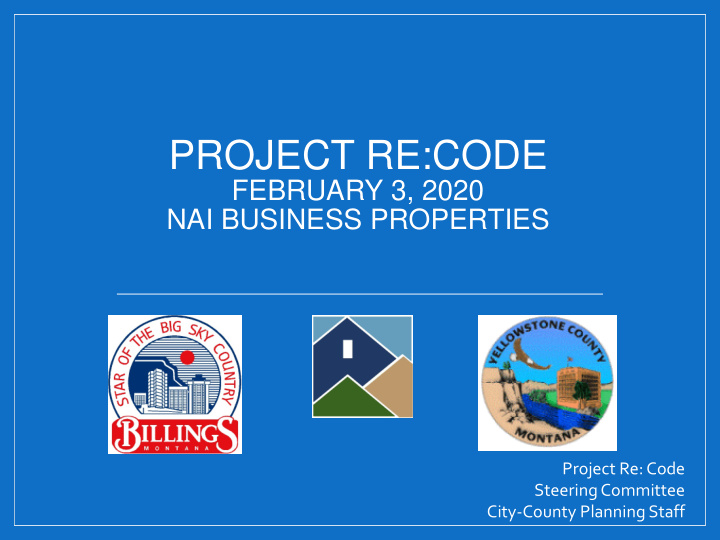



PROJECT RE:CODE FEBRUARY 3, 2020 NAI BUSINESS PROPERTIES Project Re: Code Steering Committee City-County Planning Staff
Important Updates • New Code Focus – 2 codes, focused on neighborhoods, re-building areas in decline, inspiring prosperity, making sure the edges mesh well • Neighborhood Districts • Commercial Districts – New and refreshed • The Map • Alcohol and Gambling – Re-tooling the code to regulate uses based on potential conflicts and impacts • Signs – One code from seven, tailoring signs for new commercial zones • Planned Neighborhood Developments • Short Term Rentals • Landscaping – Point-based system with enforceability • Off-street Parking – Adjusting for new code – allowing options FAQs Next Steps
New Code Focus • Integrity of Neighborhoods • Code for existing character • Strengthen Areas in Decline • Flexibility to adapt and renew • Economic Prosperity • Fill the code gaps and voids • Build in walkable neighborhood service centers • Support and inspire core sectors – medical, higher education, finance, agriculture, energy and hospitality
N is for N eighborhood • R esidential zones = N eighborhood zones • 10 R zones consolidated to 7 N zones • Focus on building form and housing choices • Lot design not just lot area
Mixed Use, Commercial, Downtown, Industrial and Public Districts
The Old Map
The New Map C3 – Commercial (County)
Alcohol and Gambling Three new zones created from CC zone district • Corridor Mixed Use 1 (CMU1) for small or shallow lots along corridors that are adjacent to or across an alley from residential neighborhoods • Corridor Mixed Use 2 (CMU2) for larger parcels, multiple uses or buildings, along corridors and in most cases not directly adjacent to a residential neighborhood • Heavy Commercial (CX) for any size parcel, located away from residential neighborhoods and not focused on retail services These zones will require “hard” separation (no waivers or variances) of Casinos, Bars & Taverns from: • Churches (religious assembly) • Schools (primary & secondary) • Parks with playgrounds • Residential zones Other zones will be “exempt” from hard separation requirements: CBD, DX, EBURD, I1 & I2
Alcohol and Gambling • Hard separation requirements will guide new casinos, bars & taverns to locations where the conflicts are minimal • Not every CMU1, CMU2 or CX location will meet new separation requirements • Measured from the physical exterior of the casino/bar & tavern to the property line of the separated use
Signs • Reducing 7 sign codes to 1 code • Updates to bring local codes into compliance with case law • Working Group reached consensus on: • Limiting districts where electronic message signs can be used • Lowering maximum sign height by 20 % in most areas • Lowering maximum sign area by 50% to 70% in most commercial districts • Built in flexibility for site characteristics – e.g. length of street frontage • Will regulate window signs as signs • New measurement standards apply to all districts
P lanned N eighborhood D evelopments Make the edges seamless New urban neighborhoods will require PND • Urban level zone districts will not be allowed outside the city limits except in Lockwood • Four types – Mixed Use, Mixed Residential, Neighborhood & Town Center •
S hort T erm R entals VRBO, AirBnB Clear regulation of use • Proposed Regulations: • Licensed with city • License is by STR location – yearly renewal • Serious complaints may result cancellation of license • Local owner or manager required • Cannot override private covenants •
Landscaping and Parking Consistent requirements across all districts - 4 landscaping codes to 1 code • Street trees required • Enforcement throughout the life of the development • Point-based system to encourage right choices for Montana climate and reducing outdoor water • use • Off-street Parking Adjusted for types of uses • Allows shared parking (day use & night use) • Specifies maximum surface parking limits • No off-street parking required in CBD or East Billings districts • Minimum bicycle parking for commercial zones (1 rack) • Off-sets for transit •
F requently A sked Q uestions Please visit the webpage https://project-recode.com/faq-page Most asked recent question: Q: Can I “up” zone my property as part of Project ReCode? A: No. The map update will translate existing zones and uses into the most appropriate new zone district. If you believe an error was made for your property please contact staff in writing explaining the issue. We will continue to update the map to correct errors until it is released for public comment. The final map will be part of the adoption process.
F requently A sked Q uestions Please visit the webpage https://project-recode.com/faq-page Most asked recent question: Q: Are Planned Development zones changing (e.g. Parkland West, Briarwood, Rehberg Ranch)? A: No. Planned Development (PD) zones are customized zone districts agreed to by the city/county and include specific requirements. These zones will not be changed and will be shown on the map as PD (Planned Development). Planning staff keeps the official record of each PD on file. Questions on specific uses within each PD can be answered by Planning staff.
Our Path Forward…… • Drafting completed by end of January 2020 • Wrapping up parking, alcohol & gaming, PNDs and procedures • Public Adoption Process • Feb/March 2020 – City and County Zoning Commissions • Topic focused hearings (4 to 5) • City Council and Commissioner hearings in April • Effective date – mid to late May 2020
Recommend
More recommend